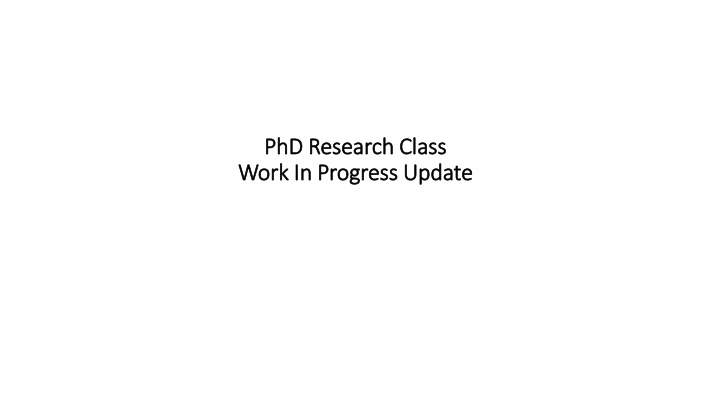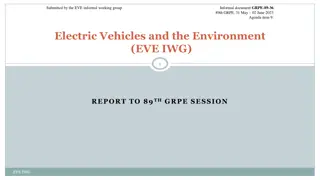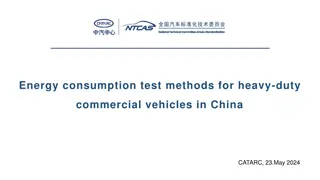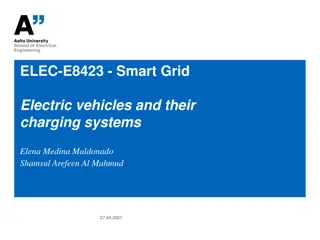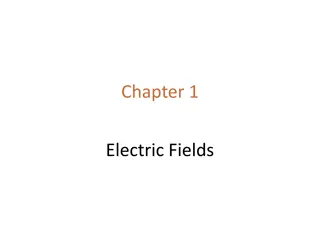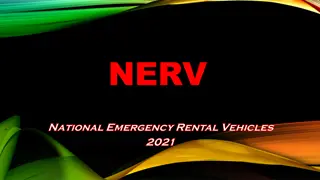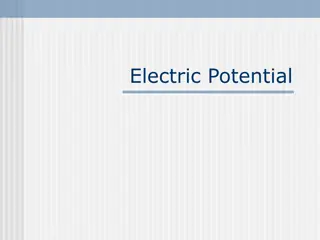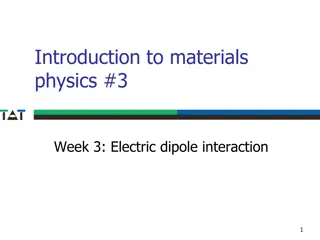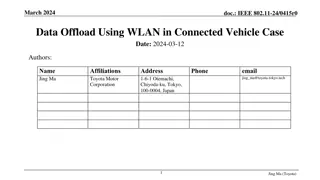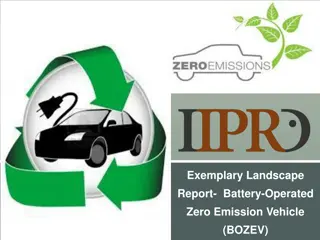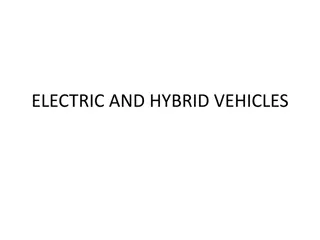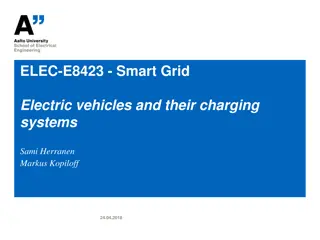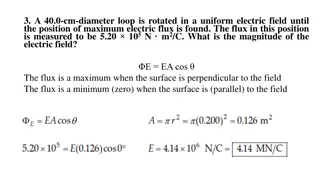Electric Vehicles Integration into Transmission Systems
The integration of electric vehicles into transmission systems presents opportunities and challenges for the power grid. With the ability to act as both consumers and suppliers of electricity, EVs can support grid stability, optimize energy usage, and facilitate power system management. Grouping EVs and utilizing their state of charge strategically can enhance grid reliability and efficiency, laying the groundwork for smarter and more sustainable energy systems.
Download Presentation

Please find below an Image/Link to download the presentation.
The content on the website is provided AS IS for your information and personal use only. It may not be sold, licensed, or shared on other websites without obtaining consent from the author.If you encounter any issues during the download, it is possible that the publisher has removed the file from their server.
You are allowed to download the files provided on this website for personal or commercial use, subject to the condition that they are used lawfully. All files are the property of their respective owners.
The content on the website is provided AS IS for your information and personal use only. It may not be sold, licensed, or shared on other websites without obtaining consent from the author.
E N D
Presentation Transcript
PhD Research Class PhD Research Class Work In Progress Update Work In Progress Update
Objective for Today 2 Describe the problem Describe the hypothesis Peer discussion
Abstract 3 The rare earth element group of minerals (REM) are classified as critical minerals, which are defined as mineral commodities essential to economic and national security. REM are essential to the manufacture of renewable energy products as well as electric vehicles, mobile communications, defense technology and other strategically important goods. Due to the pervasive risk of REM supply chain disruption, they are receiving significant global attention and commensurate funding. Domestically, U.S. policy focuses on creating a comprehensive strategy to increase the resilience of strategic and critical material supply chains that both expands sustainable production and processing capacity and works with allies and partners to ensure secure global supply (White House, 2021). While resilient supply chains are necessary, robust value chains are needed to protect economic stability and national security for the long-term. This work develops agent-based dynamic simulation models to examine innovative policy scenarios for building robust REM value chains supported by resilient supply chains.
4 1. Introduction
REE Uses & 2025 Forecast 5 Goode, J. (2018). Provenance and Traceability of Rare Earth Products (p. 27). CSA Group. Statista. (2020). Rare earth demand worldwide by application 2019 and 2025. Statista. https://www.statista.com/statistics/449722/rare-earth- estimated-demand-globally-by-application/
REEs: Critical and Strategic 6 *REE are critical minerals essential for US$20T of GDP in strategic industries* *The White House. (2021). Building Resilient Supply Chains, Revitalizing American Manufacturing, and Fostering Broad-based Growth 100-Day Reviews Under Executive Order 14017. The White House. Nassar, N. T., Alonso, E., & Brainard, J. L. (2020). Investigation of U.S. Foreign Reliance on Critical Minerals U.S. Geological Survey Technical Input Document in Response to Executive Order No. 13953 Signed September 30, 2020 (Open-File Report Open-File Report 2020 1127; Mineral Resources Program, p. 50). U.S. Geological Survey. https://doi.org/ 10.3133/ ofr2020112
It all started in the mid-80s 7 Mid-80s: REE dominance shifted from US to China when DoE classified REE as a radioactive source material Most REE processing has radioactive (Thorium, Radium) waste Rare Earth Element Production 1950 - 2020. Source: King, H. M. (2021). REE - Rare Earth Elements Metals, Minerals, Mining, Uses. Geology.Com. https://geology.com/articles/rare-earth-elements/
and hit home in 2010. 8 2010: China supply chain disruption triggered pricing instability, setting in motion the classification of REE as critical minerals
Current State of the REE Industry 9 REE industry continues to be dominated by a single actor China Post-2010: Australia, US, EU, Canada, Japan implement policies to re- establish stable global REE supply chains from new & recycled sources Chinese REE policy is a roadblock to using recycled material 2015: REE added to Critical & Strategic Minerals 2019 & Ongoing: Gov t policies (& money) to re-establish REE industry outside of China
10 2. Rare Earth Value Chain Mining-to-Manufacturing
REE Supply Chain 11 Forrester, J. W. (1961). Industrial Dynamics. Pegasus Communications, Inc. (based on R. W. Ballmer) Mines Concentrators Smelters Refiners Fabricators Manufacturing Separation & Purification Metals Processing/ Making Exploration Mining Processing Alloying Manufacturing Extract Ore, Coal End Use Alloy Making Crushing Leaching Electrolysis OR Impurity Removal Metallothermic Reduction Milling Processing Separation Super Alloys or Permanent Magnet Alloys REE REO Metals Concentrate (RE Oxide) adapted from: NETL. (2021). Critical Minerals Sustainability Program. Netl.Doe.Gov. https://www.netl.doe.gov/coal/rare-earth- elements/program-overview/background Renewable Energy, Consumer and Defense Industry Products
Supply Chain (SC) vs. Value Chain (VC) 13 Supply Chain Thinking Reduce costs, increase margins and increase market share Value Chain Thinking Add value and segment the market with differentiated products designed to increase profitability at all stages in the chain Objectives Material Flow Focus on efficiency, market access and increased distribution Focus on quality, service and agility with distribution determined by consumer demand rather than capacity utilization Information Protected and perceived as a source of arbitrage. Exchange restricted to transactional data Shared and perceived as a source of competitive advantage; strategic information shared with trusted partners Relationships Arm s length, focus on supply chain efficiency, leveraging scale and market power to secure favourable terms of trade Collaborative focus on supply chain resilience and shared resource allocation shared risk and shared benefits adapted from Fearne, A., Garcia Martinez, M., & Dent, B. (2012). Dimensions of sustainable value chains: Implications for value chain analysis. Supply Chain Management: An International Journal, 17(6), 575 581. https://doi.org/10.1108/13598541211269193
VC provides critical SC feedback 15 there is a limit to how much cost savings and business growth business executives can derive from the traditional supply chain (1) Months into a $3 billion U.S. effort to manufacture tens of thousands of ventilators to stave off coronavirus deaths, the government stockpile is facing a glut. The scenario that actually ended up happening was substantially lower... (2) (1) Simchi-Levi, D. (2010). Operations Rules: Delivering Customer Value through Flexible Operations. MIT Press. (2) Siddiqui, F. (2020 August 18). Ventilators built in a hurry now sit unused. Washington Post.
VC/SC with Feedback 16 Buyer-Driven Value Chain Product-Driven Value Chain Feedback Supply Chain R&D/ Innovation Demand Forecast Product Support adapted from Laudal, D. A. (2017). Evaluation of Rare Earth Element Extraction From North Dakota Coal-Related Feed Stocks [Dissertation]. UND.
19 3. Transformational Change Framework
VC Transformation Framework 20 One theoretical approach that has been extensively applied to the study of transitions, especially that of energy systems, and is well- established in the transitions research community, is the multi-level perspective, or MLP. (emphasis added) Hansen, P., Liu, X., & Morrison, G. M. (2019). Agent-based modelling and socio-technical energy transitions: A systematic literature review. Energy Research & Social Science, 49, 41 52. https://doi.org/10.1016/j.erss.2018.10.021 Geels, F. W., Sovacool, B. K., Schwanen, T., & Sorrell, S. (2017). The Socio-Technical Dynamics of Low-Carbon Transitions. Joule, 1(3), 463 479. https://doi.org/10.1016/j.joule.2017.09.018 Fig. 1. from Hansen et al
22 4. Dynamic Simulation of the REE Value Chain
Dynamic Hypothesis 23 Rare earth element (REE) supply chain and value chain behaviour models are required to optimize for long-term REE stability and sustainability Stability means: supply chain: frictionless movement of goods (mine to manufacturing) value chain: frictionless payments for real value-add (excludes economic rent) real value-add requires feedback no government transfers (subsidies) in long (> 10yr) term Sustainability means: operations are exergy efficient (exergy efficiency objectives TBD)
Model Sector Map* * with inspiration from Dr. D. Wheat and Macrodynamics: see Cavana, R. Y., Dangerfield, B. C., Pavlov, O. V., Radzicki, M. J., & Wheat, I. D. (Eds.). (2021). Feedback Economics: Economic Modeling with System Dynamics. Springer International Publishing. https://doi.org/10.1007/978-3-030-67190-7 25 Domestic Government Supply Demand Consumer Alloying Policy: Regulation Extract & Concentrate Renewable Energy Inventories Manu- facturing Policy: Stimulation Separate & Purify Defense Industry Foreign Regulated Supply Non-Regulated Supply
Ventity: Agent-based modeling 26 Jones, L. (2021) Business18.vmdl Ventity sample model . Ventana Systems Inc.
27 5. Scenario-Based Model Testing
Scenario Tests V0.000001 Scenario Tests V0.000001 28 Domestic Government Supply Demand Consumer Policy: Regulation Extract & Concentrate Renewable Energy Alloying Inventories Policy: Funding Separate & Purify Manu- facturing Defense Industry Technical Innovation Foreign Business Innovation Regulated Supply Non-Regulated Supply Policy Innovation
TBD: Exergy Analysis Technical Innovation Scenarios 29 Separation & Purification Metals Processing/ Making Mining Processing Exergy Analysis Exergy analysis will follow the concepts outlined in Ayres, R. U. (2010). Energy Intensity, Efficiency and Economics. INSEAD. Energy available to do useful work is exergy. Exergy is a factor of production. Exergy analysis will be used to determine the sustainability of a given scenario. Dincer, I., & Rosen, M. A. (2005). Thermodynamic aspects of renewables and sustainable development. Renewable and Sustainable Energy Reviews, 9(2), 169 189. https://doi.org/10.1016/j.rser.2004.02.002
Exergy analysis - comparison 30 Separation & Purification Metals Processing/ Making Exergy: fuel to metal Separation & Purification Metals Processing/ Making Mining Processing Exergy: mine to metal
Evolving in Real Time 31 50% funding 40 months Nd/Pr for magnets
